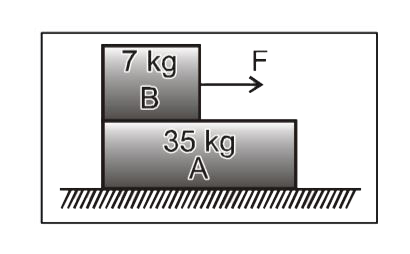A slab of 40kg lying on a frictionales floor and a block of 10 kg rests on the slab as shown in the figure. The coefficients of static and kinetic friction between the slab and the block are 0.6 and 0.4 respectively. If a force of 100N is applied on the block, then the acceleration the slab will be (g=10m/s2)

15.5m/s2
155m/s2
1.5m/s2
1m/s2
The correct Answer is:D
A slab of ………..
Let both the block and slab are moving together

100−f=10a
f=40a
100=50a
a=2
f=40×2=80
flim=μ×10×g
=0.6×10×10
=60N
so block and slab will not move together

40=40a
a=1m/s2
Similar Questions
Block A of mass 5 kg is resting on a frictionless floor. Another block B of mass 7kg is resting on it as shown in the figure. The coefficient of friction between the blocks is 0.5 while kinetic friction is 0.4. If a force of 100 N is applied to block B, the acceleration of the block A will be (g=10ms−2) :

View SolutionA block of mass 2kg is resting on a rough horizontal surface.The coefficients of static and kinetic frictions between the block and surface are 0.7 and 0.6 respectively.A horizontal force F=(4Ns)×t is applied on the block at t=0.At t=4s ,the force of friction on the block is (take g=10ms2)
View Solution
Knowledge Check
A block of mass 5 kg is placed on a rough horizontal plane. The coefficient of static and kinetic friction between the block and surface is 0.5 and 0.3 respectively. A force of 100 N is applied at an angle of 30∘ from the horizontal as shown in the figure. The acceleration of the block will be [g=10m/s2]
 A(10−√3)√3m/s2B20m/s2CzeroD10√3m/s2
A(10−√3)√3m/s2B20m/s2CzeroD10√3m/s2A block of mass 5kg is lying on a rough horizontal surface. The coefficient of static and kinetic friction are 0.3 and 0.1 and 10m/s−2. If a horizontal force of 50N is applied on the block, the frictional force is
A25NB5NC10NDZeroConsider the arrangement shown in the figure. The coefficient of friction between the two blocks is 0.5 and between the 4 kg block and the horizontal surface is 0.4. If a horizontal force of 12 N is applied on the 4 kg block, the acceleration of the 2 kg block would be
 A2.5m/s2B2m/s2C5m/s2Dzero
A2.5m/s2B2m/s2C5m/s2Dzero
A 40 kg slab rests on a frictionless floor . A 10 kg block rests on the top of the slab . [Fig. 7.81 (a)] . The coefficients of static and dynamic friction are 0.60 and 0.40 respectively . The 10 kg block is pulled by a horizontal force of 100 N . what are the resulting accelerations of (a) the block (b) the slab ? ( g = 10m/s2)

View SolutionIf the mass of the block A = 10 kg and the coefficient of static and kinetic friction is 0.2, then the mass of block B to start the motion is

View SolutionA block of mass m=4kg is placed oner a rough inclined plane as shown in figure. The coefficient of friction between the block and the plane is μ=0.5 . A force F=10N is applied on the block at an angle of 30∘ .

View SolutionA block of mass 5kg is lying on a rough horizontal surface. The coefficient of static and Kinetic friction are 0.3and0.1 and g=10m/s−2 If a horizontal force of 50N is applied on the block, the frictional force is
View SolutionBlock A is placed on cart B as shown in figure . If the coefficient of static and kinetic friction between the 20 kg block A and 100 kg cart B are both essentially the same value of 0.5 : (g = 10m/s2)

View Solution